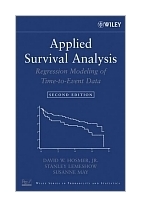|
||
• wydawnictwa polskie
• Zamów informacje o nowościach z wybranego tematu • kontakt
• Cookies na stronie |
APPLIED SURVIVAL ANALYSIS: REGRESSION MODELING OF TIME TO EVENT DATAHOSMER D.W. LEMESHAW S. MAY S.wydawnictwo: WILEY-BLACKWELL , rok wydania 2008, wydanie Icena netto: THE MOST PRACTICAL, UP-TO-DATE GUIDE TO MODELLING AND ANALYZING TIME-TO-EVENT DATA—NOW IN A VALUABLE NEW EDITION Since publication of the first edition nearly a decade ago, analyses using time-to-event methods have increase considerably in all areas of scientific inquiry mainly as a result of model-building methods available in modern statistical software packages. However, there has been minimal coverage in the available literature to9 guide researchers, practitioners, and students who wish to apply these methods to health-related areas of study. Applied Survival Analysis, Second Edition provides a comprehensive and up-to-date introduction to regression modeling for time-to-event data in medical, epidemiological, biostatistical, and other health-related research. This book places a unique emphasis on the practical and contemporary applications of regression modeling rather than the mathematical theory. It offers a clear and accessible presentation of modern modeling techniques supplemented with real-world examples and case studies. Key topics covered include: variable selection, identification of the scale of continuous covariates, the role of interactions in the model, assessment of fit and model assumptions, regression diagnostics, recurrent event models, frailty models, additive models, competing risk models, and missing data. Features of the Second Edition include:
Analyses throughout the text are performed using Stata® Version 9, and an accompanying FTP site contains the data sets used in the book. Applied Survival Analysis, Second Edition is an ideal book for graduate-level courses in biostatistics, statistics, and epidemiologic methods. It also serves as a valuable reference for practitioners and researchers in any health-related field or for professionals in insurance and government. Table of Contents
Preface. 1. Introduction to Regression Modeling of Survival Data. 1.1 Introduction. 1.2 Typical Censoring Mechanisms. 1.3 Example Data Sets. Exercises. 2. Descriptive Methods for Survival Data. 2.1 Introduction. 2.2 Estimating the Survival Function. 2.3 Using the Estimated Survival Function. 2.4 Comparison of Survival Functions. 2.5 Other Functions of Survival Time and Their Estimators. Exercises. 3. Regression Models for Survival Data. 3.1 Introduction. 3.2 Semi-Parametric Regression Models. 3.3 Fitting the Proportional Hazards Regression Model. 3.4 Fitting the Proportional Hazards Model with Tied Survival Times. 3.5 Estimating the Survival Function of the Proportional Hazards Regression Model. Exercises. 4. Interpretation of a Fitted Proportional Hazards Regression Model. 4.1 Introduction. 4.2 Nominal Scale Covariate. 4.3 Continuous Scale Covariate. 4.4 Multiple-Covariate Models. 4.5 Interpreting and Using the Estimated Covariate-Adjusted Survival Function. Exercises. 5. Model Development. 5.1 Introduction. 5.2 Purposeful Selection of Covariates. 5.2.1 Methods to examine the scale of continuous covariates in the log hazard. 5.2.2 An example of purposeful selection of covariates. 5.3 Stepwise, Best-Subsets and Multivariable Fractional Polynomial Methods of Selecting Covariates. 5.3.1 Stepwise selection of covariates. 5.3.2 Best subsets selection of covariates. 5.3.3 Selecting covariates and checking their scale using multivariable fractional polynomials. 5.4 Numerical Problems. Exercises. 6. Assessment of Model Adequacy. 6.1 Introduction. 6.2 Residuals. 6.3 Assessing the Proportional Hazards Assumption. 6.4 Identification of Influential and Poorly Fit Subjects. 6.5 Assessing Overall Goodness-of-Fit. 6.6 Interpreting and Presenting Results From the Final Model. Exercises. 7. Extensions of the Proportional Hazards Model. 7.1 Introduction. 7.2 The Stratified Proportional Hazards Model. 7.3 Time-Varying Covariates. 7.4 Truncated, Left Censored and Interval Censored Data. Exercises. 8. Parametric Regression Models. 8.1 Introduction. 8.2 The Exponential Regression Model. 8.3 The Weibull Regression Model. 8.4 The Log-Logistic Regression Model. 8.5 Other Parametric Regression Models. Exercises. 9. Other Models and Topics. 9.1 Introduction. 9.2 Recurrent Event Models. 9.3 Frailty Models. 9.4 Nested Case-Control Studies. 9.5 Additive Models. 9.6 Competing Risk Models. 9.7 Sample Size and Power. 9.8 Missing Data. Exercises. Appendix 1: The Delta Method. Appendix 2: An Introduction to the Counting Process Approach to Survival Analysis. Appendix 3: Percentiles for Computation of the Hall and Wellner Confidence Band. References. Index. 416 pages, Hardcover Księgarnia nie działa. Nie odpowiadamy na pytania i nie realizujemy zamówien. Do odwolania !. |


